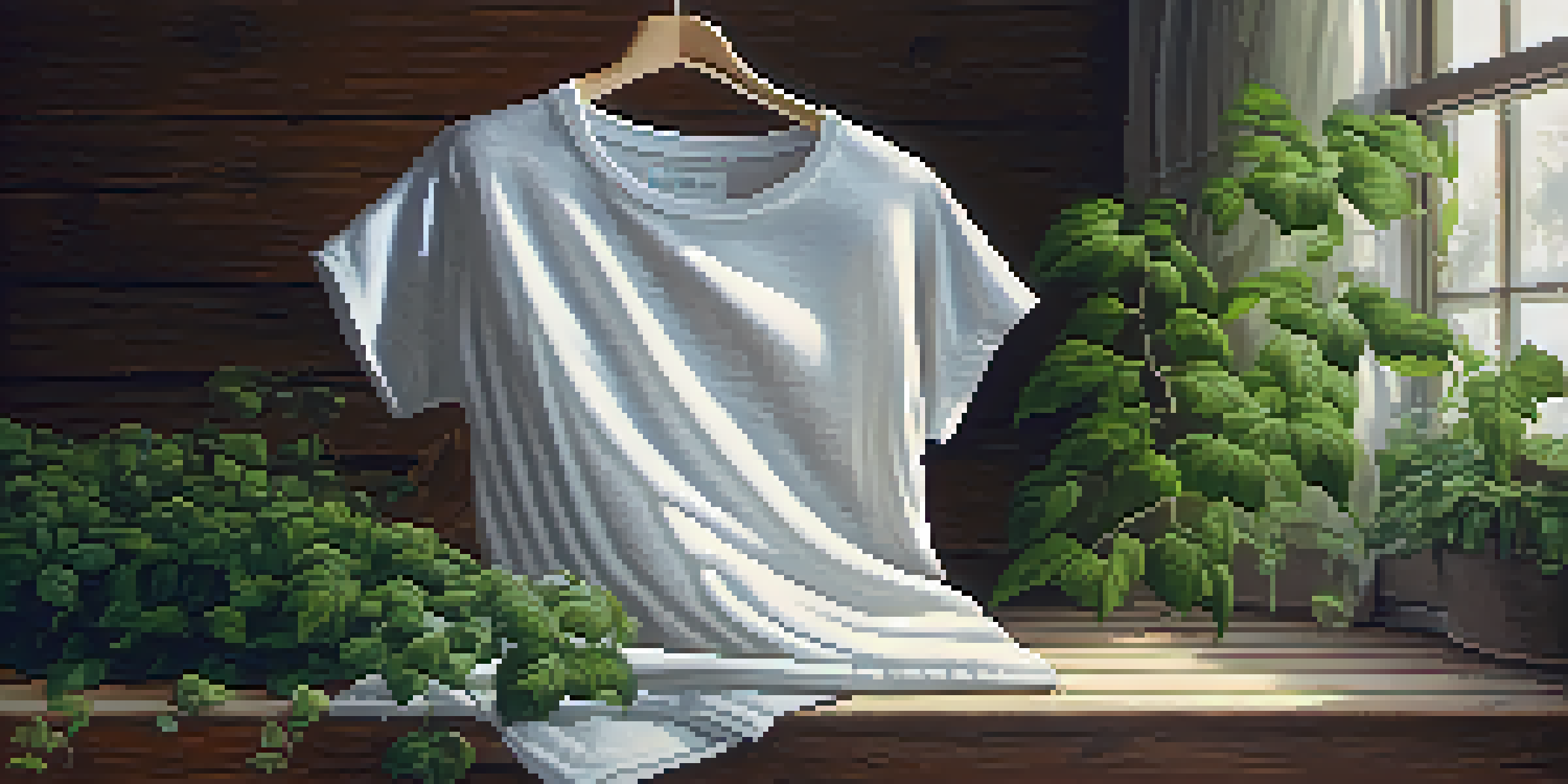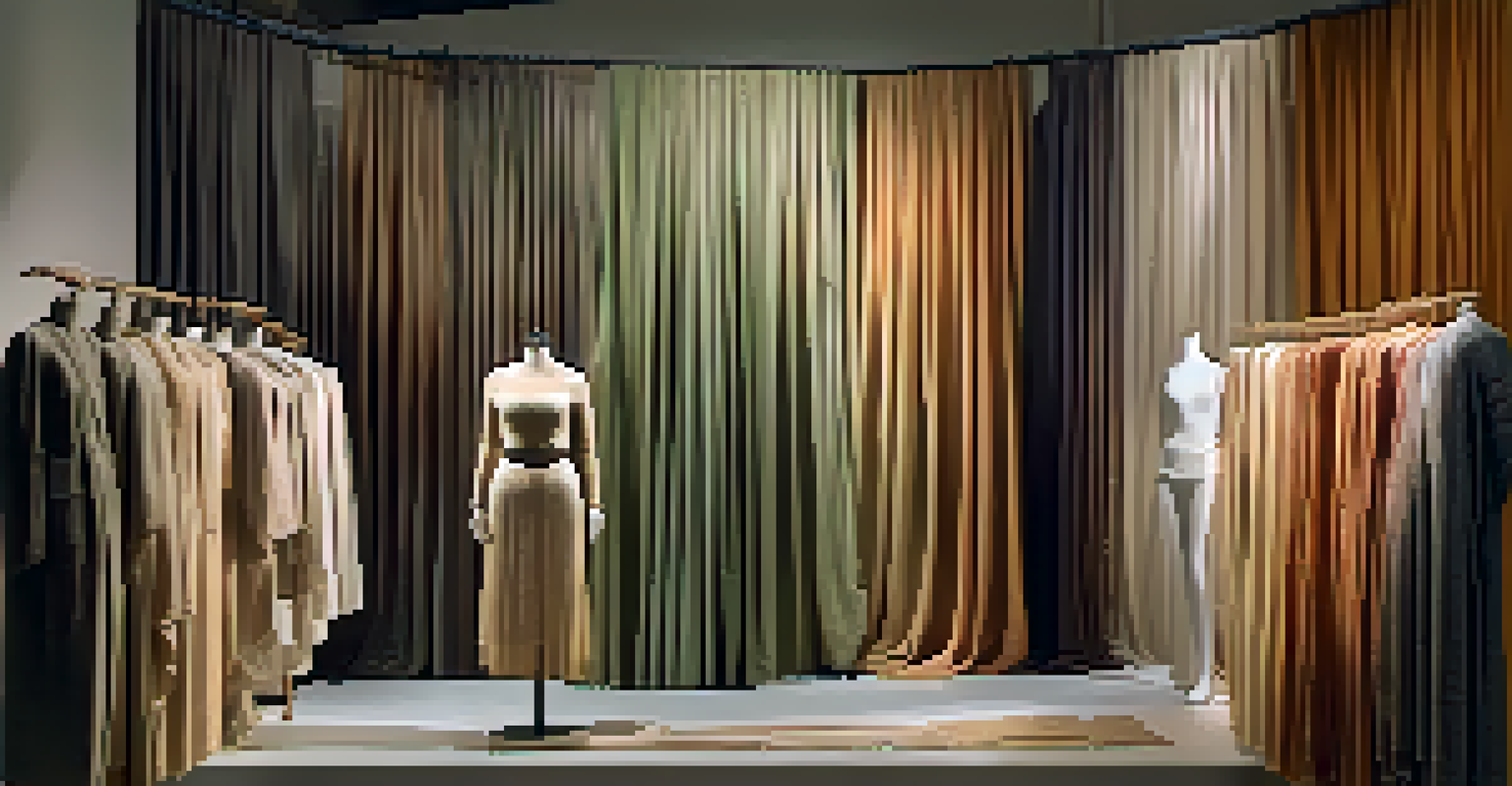Sustainable Fabrics: The Future of Eco-Friendly Fashion Choices

Understanding Sustainable Fabrics and Their Importance
Sustainable fabrics are materials made with environmentally-friendly processes that minimize harm to the planet. They often come from renewable resources or use recycled materials, making them a key player in reducing fashion's carbon footprint. As consumers become more conscious of their choices, the demand for these fabrics continues to rise.
Fashion is the armor to survive the reality of everyday life.
Think of sustainable fabrics as the superheroes of the fashion world, fighting against pollution and waste. They not only help preserve our environment but also promote ethical practices within the fashion industry. By choosing these materials, shoppers can support brands that prioritize sustainability and social responsibility.
Ultimately, the shift towards sustainable fabrics represents a larger movement towards eco-friendly living. As we explore the various types available, it's crucial to understand how each contributes to a more sustainable future, not just for fashion but for the planet as a whole.
Cotton: The Classic Choice with a Green Twist
Cotton has been a staple in fashion for centuries, but its traditional farming practices can be quite harmful to the environment. Luckily, organic cotton has emerged as a sustainable alternative, grown without harmful pesticides and requiring less water. This eco-friendly version maintains the softness and breathability we love while being gentler on the Earth.

Imagine wearing a t-shirt that feels great and also supports sustainable farming. Organic cotton farmers use methods that promote biodiversity and soil health, ultimately creating a more sustainable ecosystem. By choosing organic cotton, consumers can enjoy their favorite fabric without the guilt of contributing to environmental degradation.
Sustainable Fabrics Reduce Impact
Sustainable fabrics are essential in minimizing fashion's carbon footprint by using eco-friendly processes and materials.
As brands increasingly adopt organic cotton in their collections, it's becoming easier to find stylish options that are both fashionable and eco-conscious. This shift not only benefits the planet but also encourages more sustainable practices within the textile industry.
Hemp: The Versatile Fabric of the Future
Hemp is a remarkable plant known for its fast growth and minimal resource requirements, making it an excellent choice for sustainable fashion. Unlike conventional crops, hemp requires little water and no pesticides, which reduces its environmental impact significantly. This adaptability allows hemp to thrive in various climates, providing a reliable source of eco-friendly fabric.
Sustainability is no longer about doing less harm. It’s about doing more good.
Think of hemp as nature's gift to the fashion world—it’s durable, breathable, and naturally resistant to mold and UV light. This resilience makes hemp fabrics not only sustainable but also practical for everyday wear. Plus, the production process is much less taxing on the environment compared to other textiles.
As hemp gains popularity in the fashion industry, we're seeing innovative designs emerge that highlight its versatility. From casual wear to high-end fashion, hemp is proving that sustainability and style can go hand in hand.
Recycled Fabrics: Turning Waste into Fashion
Recycled fabrics are making waves in the fashion industry by transforming waste materials into stylish clothing. By repurposing plastic bottles, discarded textiles, and other waste, brands are reducing the need for new raw materials and minimizing landfill contributions. This process not only conserves resources but also encourages a circular economy.
Picture a trendy jacket made from recycled plastic bottles—it's not only fashionable but also a testament to innovation in sustainability. Many companies are embracing this practice, creating collections that highlight the importance of recycling and waste reduction. This approach resonates with eco-conscious consumers who want to make a positive impact with their purchases.
Organic Cotton Supports the Earth
Organic cotton is a sustainable alternative that promotes biodiversity and reduces environmental harm associated with traditional cotton farming.
As the technology behind recycling fabrics continues to improve, we can expect to see even more creative uses for repurposed materials. Embracing recycled fabrics is a step toward a more sustainable fashion future, proving that style and environmental responsibility can coexist.
Tencel: The Soft and Sustainable Superstar
Tencel, also known as lyocell, is a fabric made from sustainably sourced wood pulp, primarily from eucalyptus trees. The production process uses a closed-loop system that recycles water and solvents, minimizing waste and environmental impact. This innovative approach makes Tencel one of the most eco-friendly fabrics available today.
Imagine wrapping yourself in a soft, breathable fabric that feels luxurious against your skin while knowing it’s sustainably made. Tencel not only offers exceptional comfort but also has moisture-wicking properties, making it ideal for activewear and everyday clothing. It's a choice that appeals to both fashionistas and eco-warriors alike.
As more brands incorporate Tencel into their collections, we're witnessing a shift towards fabrics that prioritize both quality and sustainability. With its blend of comfort and eco-friendliness, Tencel is paving the way for a new generation of textiles that meet the demands of modern consumers.
Bamboo: Nature's Sustainable Fabric
Bamboo is often touted as a sustainable fabric due to its rapid growth and minimal resource needs. It naturally thrives without pesticides or fertilizers, making it an eco-friendly option for clothing. Additionally, bamboo absorbs carbon dioxide and releases oxygen, contributing positively to the environment during its growth cycle.
Just picture wearing a soft, breathable garment made from bamboo fibers—it's not only comfortable but also has natural antibacterial properties. This makes bamboo fabrics an excellent choice for activewear and undergarments, providing both style and functionality. Consumers can feel good knowing they're supporting a sustainable industry.
Future Trends Embrace Innovation
The future of sustainable fabrics includes innovative materials like mushroom leather and algae-based textiles that further advance eco-friendly fashion.
As bamboo continues to gain traction in the fashion world, it’s essential for brands to ensure their production methods are truly sustainable. Educating consumers about bamboo's benefits helps encourage responsible choices while promoting a more eco-friendly approach to fashion.
Future Trends in Sustainable Fabrics
As we look ahead, the future of sustainable fabrics is bright, with innovation driving exciting developments. Brands are increasingly exploring new materials, such as mushroom leather and algae-based textiles, that further reduce environmental impact. These groundbreaking options promise to expand the possibilities of eco-friendly fashion.
Imagine a world where your favorite pieces are made from materials that not only look good but also help heal the planet. As technology advances, we can expect to see more collaborations between fashion designers and scientists, leading to the creation of fabrics that are both stylish and sustainable. This fusion of creativity and innovation will shape the future of the fashion industry.

Ultimately, the shift towards sustainable fabrics signals a broader cultural change, as consumers demand more responsible choices. By embracing these trends, we can all contribute to a more sustainable future, one fashionable piece at a time.
How to Make Eco-Friendly Fashion Choices
Making eco-friendly fashion choices starts with awareness and intention. Consumers can begin by researching brands that prioritize sustainable materials, ethical labor practices, and transparent supply chains. By supporting these companies, shoppers can encourage the fashion industry to adopt more sustainable practices.
Another practical step is to consider the lifecycle of clothing—opting for quality over quantity can lead to a more sustainable wardrobe. Investing in timeless pieces made from sustainable fabrics not only benefits the environment but also ensures lasting use. Additionally, embracing second-hand shopping and clothing swaps can extend the life of garments and reduce waste.
Sustainable Fabrics Reduce Environmental Impact
Sustainable fabrics are produced using eco-friendly processes that minimize harm to the planet, helping to reduce the fashion industry's carbon footprint.
Ultimately, every small decision can make a difference. By becoming more mindful of our fashion choices, we can foster a culture of sustainability that encourages brands and consumers alike to prioritize the planet.